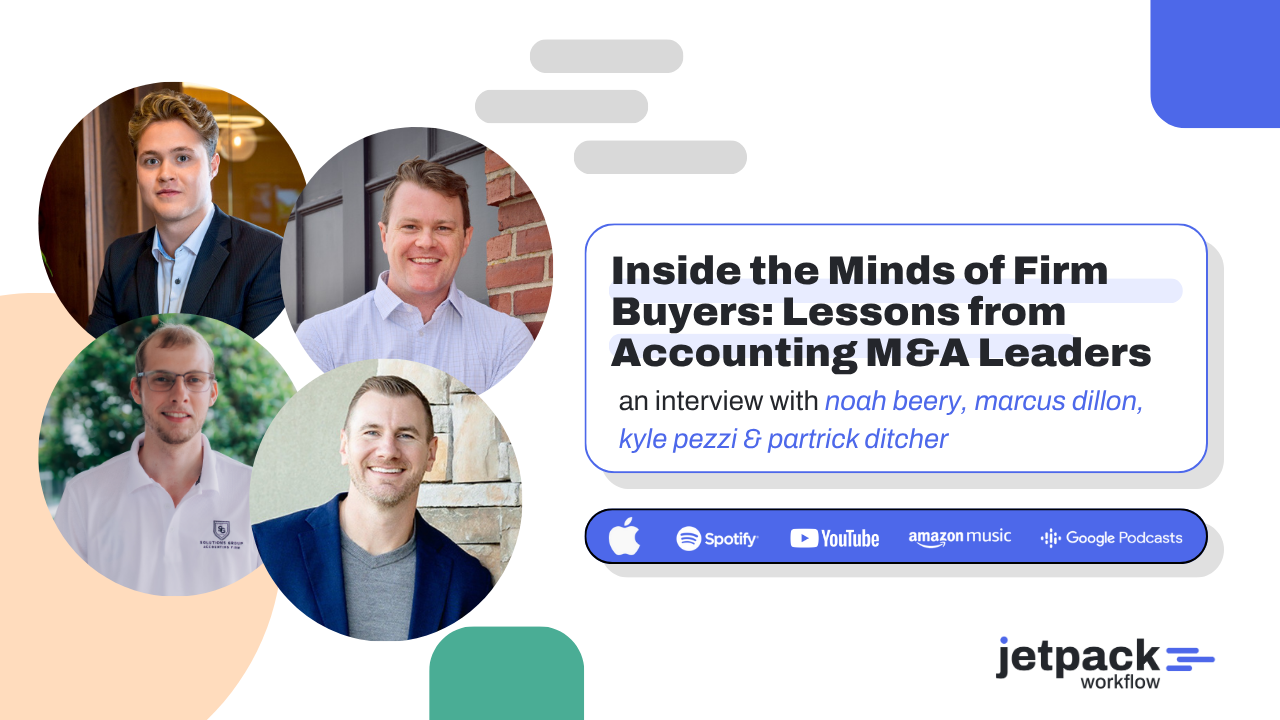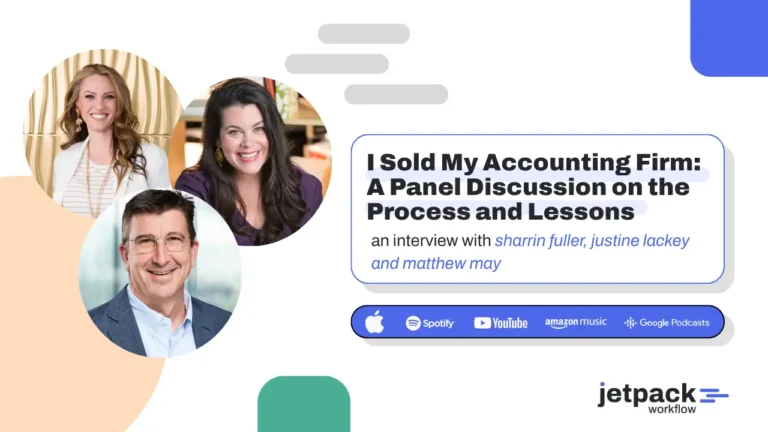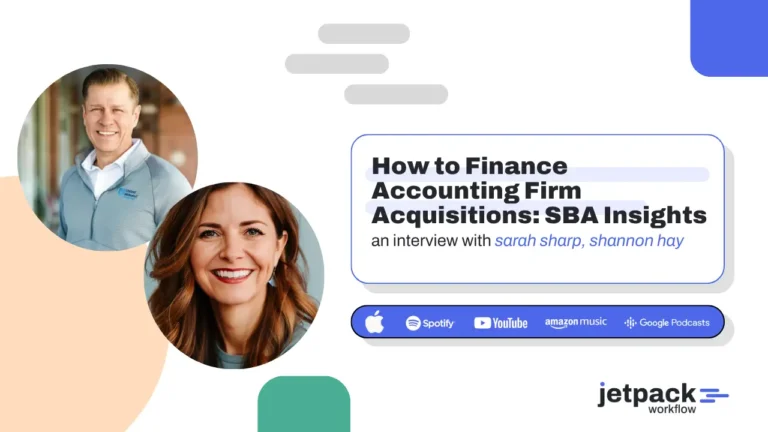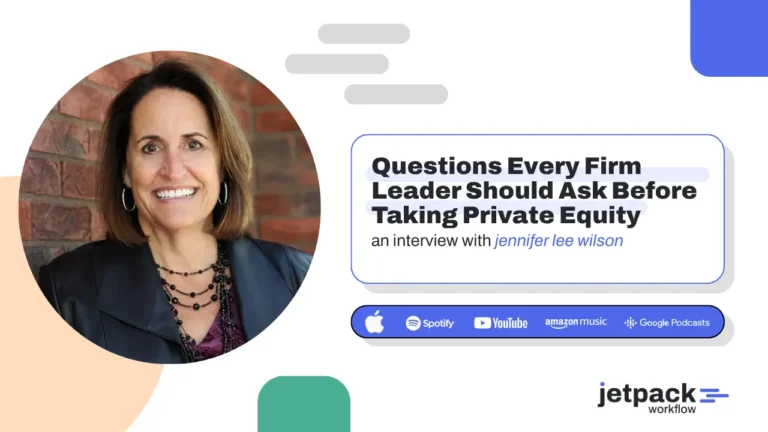Inside the Minds of Firm Buyers: Lessons from Accounting M&A Leaders

Featuring insights from Noah Beery (Platform Accounting Group), Marcus Dillon (Dillon Business Advisors), Kyle Pezzi (Solutions Group), and Patrick Ditcher (Appletree Business Services)
The fifth and final session of the Jetpack Workflow M&A Summit brought together four seasoned firm buyers who shared what it really takes to find, acquire, and integrate accounting firms successfully.
While each operates at a different scale, their message was consistent: buying firms can accelerate growth, but it is not easy money. It is people, process, and purpose combined.
Key Takeaways
-
Fit and culture outweigh firm size or valuation.
-
Tech stack alignment simplifies integration.
-
Coachable owners make smoother partners.
-
Integration requires leadership and communication.
-
There is no perfect deal, only prepared buyers.
-
Firms succeed when values and people align.
Meet the Panelists
Noah Beery, Head of Corporate Development at Platform Accounting Group, oversees more than 55 acquisitions across 14 states. His team focuses on preserving the local firm feel while providing large-scale operational support.
Marcus Dillon, CPA and founder of Dillon Business Advisors, first bought a firm at 28 and now leads one of Accounting Today’s Best Firms to Work For.
Kyle Pezzi, CEO of Solutions Group Accounting, acquired his first firm through a search fund and brings a finance and investment banking background to the table.
Patrick Ditcher, owner of Appletree Business Services, entered the profession through small business consulting and has since scaled his firm through multiple acquisitions.
1. What Makes a Good Fit for Acquisition
Marcus Dillon shared that fit starts with alignment to the firm’s growth plan and culture, not just financial metrics.
“We only pursue acquisitions that expand opportunity for our team. Capacity, technology, and coachability matter more than size.” – Marcus Dillon.
His firm evaluates two key traits before moving forward:
-
Tech Stack Compatibility – Similar systems make post-close integration smoother.
-
Coachability – Owners who have worked with coaches or mentors are more likely to adapt to a collaborative model.
2. The Top Red Flags to Watch For
Noah Beery, whose team has handled over 50 acquisitions, emphasized cultural and operational readiness.
A big red flag is resistance to technology. If a firm insists on staying paper-based or rejects modern tools, integration becomes impossible.” – Noah Beery
Common red flags include:
-
Paper-based workflows or heavy manual systems
-
Owner dependency with extremely high production hours
-
Outdated pricing models that undercut margins
Beery added that alignment is easier when the seller has already experienced business coaching or systemized leadership training.
3. Integration Challenges: Change Management and Reality
Patrick Ditcher was direct about post-acquisition challenges.
Integration is hard. Change management is difficult. If you think everyone will love your new systems on day one, they will not.” – Patrick Ditcher
His advice is to lead decisively after a transition.
At some point, you have to stop playing defense and go on offense. Be clear about where the firm is going, or you will never gain traction.” added Ditcher.
Kyle Pezzi agreed, emphasizing the need for empathy and communication.
Accountants dislike change. You have to show how life improves for employees, not just expect compliance.” – Kyle Pezzi.
For post-acquisition strategies, read The First 100 Days After an Acquisition.
4. Pricing, Margins, and Productivity Metrics
The conversation shifted toward financial metrics, where each buyer shared their benchmarks.
Kyle Pezzi looks for revenue per employee in the range of 130,000 to 180,000 dollars depending on firm mix. He focuses less on scale and more on transferability and culture.
Marcus Dillon targets higher productivity ratios for Client Accounting Services (CAS) firms:
-
Four times salary for client service managers
-
Three times for controllers or tax managers
-
Two times for directors or CFOs
We aim for 250,000 dollars per employee on average. Beyond that, we track owner production hours. Less than 1,200 per year is ideal.” – Marcus
Noah Beery added that while some firms can exceed those figures, high revenue per head often hides unsustainable workloads.
If the owner is billing 2,900 hours a year, that is not scalable.” – Noah
To understand deal financing options, see How to Finance Accounting Firm Acquisitions.
5. Handling Sellers and Cultural Transition
Buyers agreed that integration success depends on empathy, structure, and clarity.
Noah Beery shared how Platform Accounting Group uses its 70-person support team to lift the administrative load from sellers immediately.
Most sellers are relieved to hand off HR, payroll, and IT. We align incentives and build a 30-60-90-day plan before closing.” – Noah
Marcus Dillon’s firm, which often acquires from peer relationships, wins deals by focusing on shared values rather than valuation.
We are not chasing the highest bid. Our sellers care most about their people and clients.” – Marcus
6. Key Lessons and Advice for Future Buyers
Each panelist offered parting thoughts for firm owners entering the M&A space.
-
Noah Beery: “Know your why. If you are doing this because LinkedIn says it is lucrative, you are not ready. This takes real work.”
-
Marcus Dillon: “Ask yourself if you want what this means. It is long nights, debt, and tough transitions. But if you are called to serve this industry, it is worth it.”
-
Kyle Pezzi: “This business is about people. If you cannot handle the human side, no amount of capital will save you.”
-
Patrick Ditcher: “There is no perfect deal. Eventually you need to act, even if the firm is not perfect.”
Learn how firm leaders evaluate investor offers in Jennifer Wilson’s Guide – Questions to Ask Before Taking Private Equity.
Frequently Asked Questions
1. What makes a firm a good acquisition fit?
A strong acquisition fit starts with cultural alignment and shared values. Buyers look for firms with similar technology stacks, modern processes, and owners who are open to collaboration and coaching.
2. What are the biggest red flags in accounting firm acquisitions?
Red flags include paper-based systems, outdated pricing models, high owner dependency, and resistance to technology or change. These issues often make integration slower and more expensive.
3. How do firm buyers handle integration challenges?
Successful buyers focus on structured change management, clear leadership, and empathy. They prioritize communication and show employees how new systems will make their work easier and more efficient.
4. How do buyers measure firm performance before acquiring?
Buyers review productivity metrics such as revenue per employee, profit margins, and owner hours. Ideal firms maintain sustainable workloads and deliver at least 200,000 dollars in annual revenue per full-time employee.
5. What advice do experienced buyers have for first-time acquirers?
Understand your motivation before buying. The process requires patience, capital, and strong leadership. Focus on culture, team alignment, and long-term fit rather than chasing the highest short-term return.
From Acquisition to Integration – Jetpack Workflow Keeps You Aligned
After every acquisition, smooth integration matters most. Use Jetpack Workflow to unify your new team, automate tasks, and maintain firm-wide productivity.





